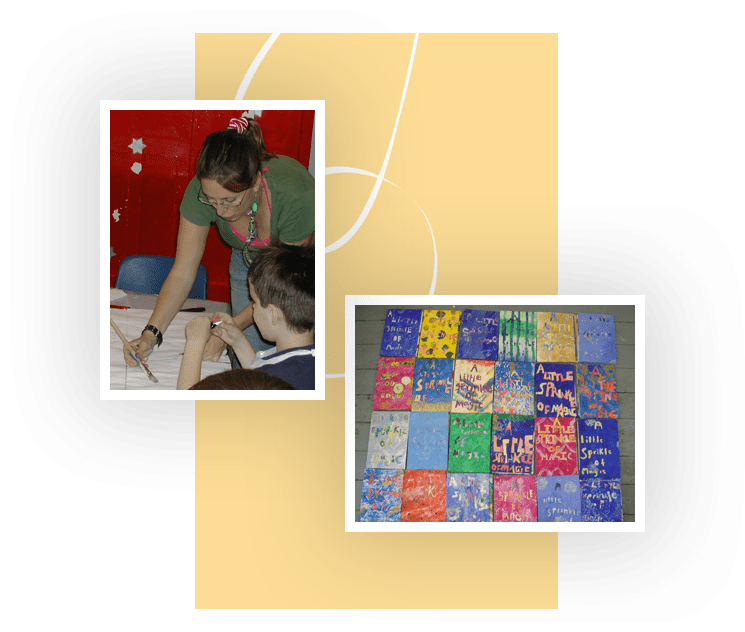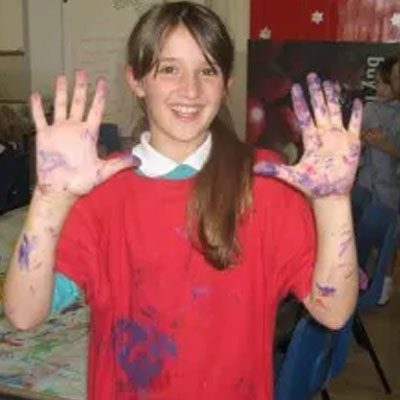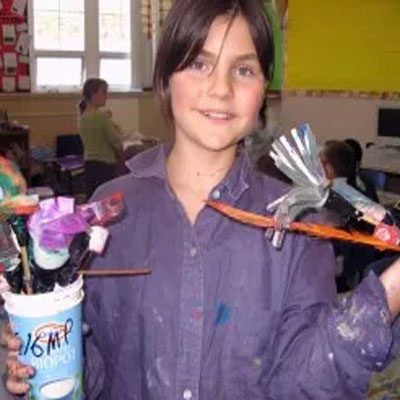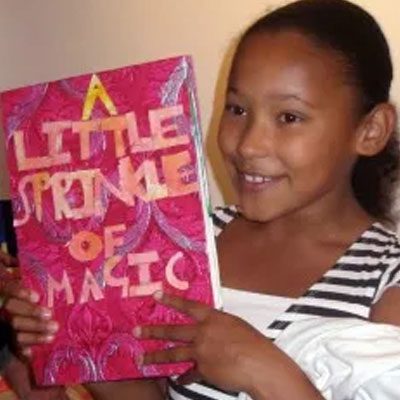
A Little Sprinkle of Magic (Cardiff, Wales)
In an incredibly fortunate turn of events, Susie twice had the privilege of working in schools in Wales. In 2006, she worked at Radnor Road Primary in Cardiff, where children collaborated on two stories, each creating an individual handmade book. In 2007 at the Llandough Primary School’s Language and Speech Unit in South Wales, she led children of varying ages and abilities as they collaborated on a story that became a giant poster-sized book with the help of Heloise Godfrey.
Smitten by accents and expressions, she became an admirer of Welsh students, who worked so beautifully together. Collaboration, it turns out, is a nationally held value. The Welsh believe in competition only at football matches.
Susie’s greatest gift was twice working with the talented, gentle, creative visual artist/teaching artist Heloise Godfrey, whom she quickly came to love as much as the students did. Heloise got amazing work from children and introduced a wealth of techniques, all of them fun. She made their experiences (and Susie’s) incredibly joyful. (The pictures attest to that.) You can view her talents at: http://www.heliosegodfrey-talbot.com
Susie was so struck by the Welsh-American differences that she, on return, wrote an article about these experiences. It was published in Teaching Artist Journal in 2007; she has recaptured and revisited “Rediscovering Wonder in Wales” to share with you:
Rediscovering Wonder in Wales
Rewritten from an article published in Teaching Artist Journal, 2007
An alien with a skin suit that needs dry cleaning, an electric teacher who hides her secret, and an old woman who knits clouds: these are only three of the hundreds of collaborative stories I’ve written with children during twenty years of working in U.S. schools. Like most teaching artists, I have a unique vantage point. Visiting many schools creates a montage of education in practice rather than theory. In over a decade and a half, I’ve seen joyful writing fade and stress flourish. When I visited Wales in 2007, I found students who still thrived on creating imaginative stories and a curriculum that permitted them to do so.
Bringing Stories to Schools
When I started writing in schools in 1990, I savored students’ spirit and imagination. I relished showing them how to make sense of stories, how to create stories that made sense, and have fun doing both. Play was the best way to combat three problems I saw recurring in every classroom I visited, where I found children couldn’t think, wonder, or take risks.
Children's’ urge to play is as innate as their sense of wonder, but by early elementary school, the sandbox and dress-up corner stories fade. Most language arts programs dedicate themselves to writing about personal experiences. This is great practice for focusing and observation, but why is fiction so underrepresented? My guess is that its lack of rules, directions, and outcomes made it messy and scary for most educators.
I better understood the situation teachers faced when I took an art class and had to create a piece of visual art. I trembled with confusion, looking at all materials I could choose. It was almost impossible to get started; I wracked my brains for an idea. Then I went crazy trying to figure out how to make my product match the picture I had in mind. Continually frustrated by technical difficulties, I was rarely pleased with my results.
Teachers have lots more to risk. I didn’t have to instruct children in something that unnerved me or get them to perform in ways that might impact my performance record or income. That is what led me to turn my inventive spirit into helping teachers by breaking down writing into manageable steps that build a complete story.
Schools and Students Shift
For five years, I responded to successes and failures. Just when I felt I’d perfected a process that flowed well, I began to see a change in students. Almost overnight, they became harder to engage, and their desire to create evaporated.
Our busy world has robbed many children of reading experiences, fantasy play, and conversations that make them excited about new learning. A kindergarten teacher told me that four and five-year-olds came to her, searching her face for the right answer, as if the demand for success had robbed them of a willingness to take risks. As if things weren’t bad enough, the trend for accountability hit the schools, and testing spread like a plague all over the U.S., intensifying with “No Child Left Behind.” Testing continues with the Common Core State Standards.
I entered a third-grade classroom one August to find children quietly bent over test papers. “They’re learning how to bubble,” the teacher whispered.
“That’s a fine way to begin the school year,” I muttered. She nodded sadly.
Teaching artists are nothing if they aren’t adaptable. I responded to the testing environment by spending the next several years developing techniques to help teachers meet their difficult curriculum goals. I stopped teaching the imaginary fiction I loved and worked to put a playful spin on writing tests, compare-contrast papers, and creating paragraphs. The teachers were pleased with my efforts. But the children were bored and, frankly, so was I.
Some of the best writing I did with students came when I lost a crown in the front of my mouth and couldn’t get it fixed before I had to return to teach a fifth-grade class. To quell my own insecurities, I had to do some fast, creative thinking.
“Notice anything new?” I asked my students, breaking into a huge grin that exposed my gaping hole.
I told them I was in a quandary and asked for help. “Would you please take five minutes to come up with an answer I can tell people who ask me, ‘What happened to your tooth?’”
There was inventiveness in “I’m really a seven-year-old pretending to be a grown-up” and voice in “Let’s just say that bungee jumping off the Empire State Building when a taxi is passing below is never fun.” One group crossed curriculum with a scientific slant, “I am really a shark and shed my teeth.” And there was reality in “I tried to eat my husband’s cooking.” These children loved creating imaginative fiction!
The Cardiff Cure
This bright moment confirmed my desire to teach imaginative fiction, and I was despairing about this when I spoke with Suzanne Greenslade, a college friend who had lived in Wales for almost thirty years and worked for the Washington Gallery in Penarth, South Wales. Part of her job was to send artists into the community and, after their residencies, honor the participants’ work with an exhibition. I imagined once again guiding children as they developed imaginary characters and stories they cared about and impulsively told her that I’d already planned a trip to Europe, and it wouldn’t be difficult to add on a teaching adventure in Wales. The plan evolved quickly. I would work with two Year 5/6 classes (equivalent to 4/5th grade) at Radnor Primary, and we’d have a week to create stories to serve as illustrative prompts for Welsh artist Heloise Godfrey.
Collaborative Fiction—Can It Cross the Ocean?
The night before the residency started, my friend advised me about language differences.
“Say ‘trousers’ because ‘pants’ means underwear and ‘bum,’ not ‘fanny.’ In Wales, ‘fanny’ refers to the front part of a woman’s lower parts.”
“Thank goodness you told me,” I said. “‘Fanny’ is part of the “Silly Willy” song I sing with children.”
“Don’t say, Willy!” she screamed. I could figure out what that meant. But I wondered what other surprises waited for me in the classroom.
The school day started as the children offered up a greeting in Welsh. Immediately I felt their respect for custom, teachers, peers, and learning. These students were immediately intrigued. Was it my celebrated American accent? Could my process hold their interest?
I began by reading aloud Deborah Wiles’ Freedom Summer, a story that takes place in a small Southern town during the first days of desegregation and tells about a young white boy who comes to understand how much his black best friend longs for equality. I discovered these well-informed students knew about segregation in America. They listened attentively to the story and then, in a discussion, told me about their perceptions of inequality in Wales. The students were convinced by the end of this activity that they would enjoy picture books and begged for more.
But I moved us along to the next activity. They were just as involved as they analyzed the book, relying on the Story Skeleton model I’ve devised to describe structure elements like setting, character traits, motivation, conflict, climax, and resolution.
“How many of you love to write?” I asked. In American classrooms, often only two eager hands wave in response, but in these classes, I had only two negatives. “How many of you like to play games?” As in America, all hands shot up. I promised that we’d play game after game and wind up with a story.
We launched into writing by inventing a list of wacky characters. Each class chose a character, and we played a game I call “Wondering Questions.” In one minute, students suggested a slew of questions that would help us understand the character. We answered these and, from all our gathered ideas, composed our narrative plan.
Then we put “flesh” on our “story bones.” In small groups, students focused on scenes, making friends with the chaos of invention. They thought up images to stimulate the senses and imagined vivid verbs to move their tales along. A ruddy-cheeked girl noticed, “You get really far when you work together.” Another offered, “It’s great to ask other people for ideas.”
Last, we used games to revise and edit a series of drafts, examining and changing words and ideas until they seemed just right. A boy with a huge smile admired “the way the story all fitted together.”
By week’s end, we had finished two stories. One classroom wrote about Zacchaeus, an annoyed older sibling who has to find his own brand of magic to rescue his little sister from an enchanted globe. In the second class, we composed the story of Storm, an innocent grape who sunbathes too long, becomes a raisin, and briefly turns to a life of violence as “his sweet side withers with his skin.”
The students’ involvement led them to a deeper understanding than I usually see in American classrooms. The play was important, but ultimately it was their stories that mattered. These children could see the bigger picture. “We used games to create work without realizing it,” marveled one child. Another understood that “stories are fun to write as well as to read.” My favorite comment came from a ten-year-old who said he’d learned, “working together has made us strong.”
The original article is available for purchase at http://www.tandfonline.com/doi/abs/10.1080/15411790701578236#.Un6LkPmsiSo




